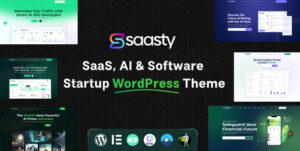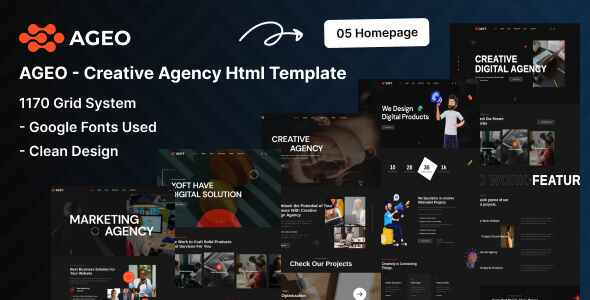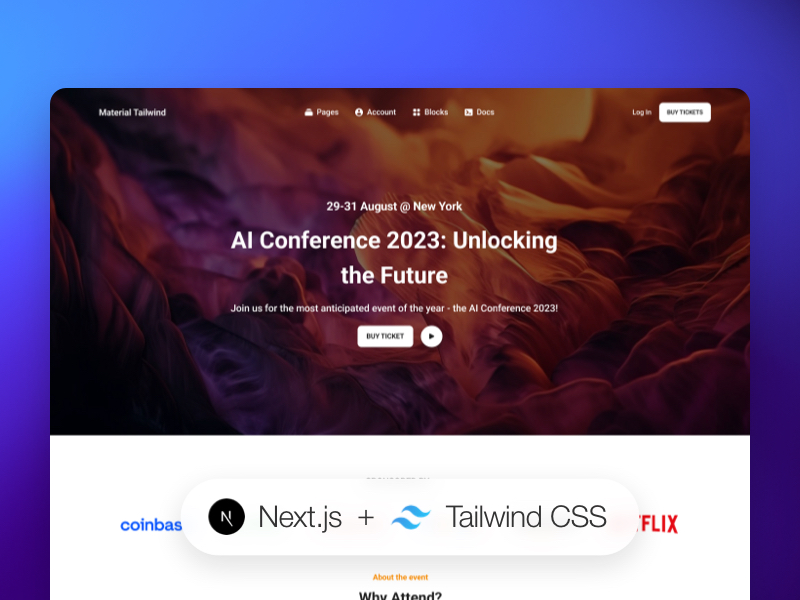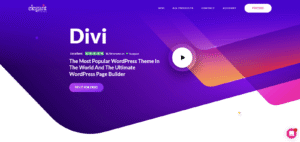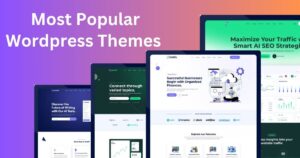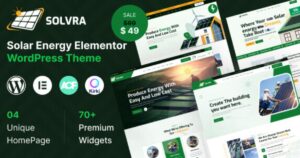Are you looking to make a striking first impression with your SaaS product? The SaaS UI Template could be your secret weapon.
Imagine capturing your audience’s attention in seconds, guiding them effortlessly through your offerings, and converting visitors into loyal customers—all with a beautifully designed landing page. In this post, we’ll explore how a SaaS landing page template can transform your online presence.
We’ll dive into design principles that captivate, content strategies that persuade, and user experiences that convert. Ready to unlock the potential of your SaaS UI Template? Let’s get started!

What Is A Saas Landing Page?
A SaaS landing page is a web page designed to promote software services. It is a high-converting landing page template for saas marketing companies. It helps create attractive, user-friendly pages. It highlights key features, benefits, and encourages visitors to take action.
A landing page is the first impression your potential customers get of your software-as-a-service product. Imagine this page as the friendly face greeting your visitors, guiding them effortlessly toward understanding and engaging with your service. It’s designed to convert curious visitors into enthusiastic users by clearly communicating the value of your product.
Understanding The Purpose Of A SaaS UI Template
It serves as your digital storefront. Its primary purpose is to capture leads and convert them into customers. Think of it as the first handshake with your visitors, offering them a glimpse into the benefits of your service. It must be tailored to address the specific needs and concerns of your target audience. Consider it a personalised pitch, crafted to engage, inform, and persuade.
Key Elements Of A Saas Landing Page
Your page should have a clear headline that speaks directly to your audience’s needs. This is the hook that draws them in. Include compelling visuals that highlight your product features. Visuals can often say what words struggle to convey. An effective call-to-action (CTA) is crucial. It should guide your visitors on the next steps, whether it’s signing up or requesting a demo.
Crafting An Engaging User Experience
Every element should work together to provide a seamless user experience. Navigation should be intuitive, making it easy for visitors to find information. Content must be concise and actionable, leaving no room for confusion. Your visitors should feel compelled to take action immediately. You can share testimonials or case studies to build trust. Seeing real-world applications often helps visitors visualize how your product fits into their lives.
Why Design Matters
A visually appealing landing page can set you apart from competitors. Design not only attracts but also retains interest. Consider your branding. Consistency in color, fonts, and imagery reinforces your identity and helps visitors remember you. Your layout should guide the visitor’s eye naturally from one section to the next. This ensures your message is absorbed effortlessly.
Engaging Your Audience
Ask yourself: Are you addressing your audience’s pain points? Your landing page should speak directly to their challenges and offer your solution. Encourage interaction. Use forms, buttons, and other interactive elements to keep visitors engaged. Test and refine. Regularly check how your page is performing and make necessary adjustments. Optimization is an ongoing process. Remember, your website is more than just a webpage. It’s an opportunity to connect with your audience and inspire action. How will you make yours stand out?
Key Elements For High Conversions
Creating a high-converting page requires a strategic approach. Each element on your page should work together to guide visitors towards taking action, whether it’s signing up, downloading a trial, or making a purchase. Let’s dive into the key elements that can boost your conversions.
Compelling Headlines
Your headline is often the first thing visitors see. It should be compelling and convey the value of your SaaS product. Use direct, powerful language that speaks to your target audience’s needs. Imagine you’re browsing for a solution—what headline would grab your attention immediately?
Engaging Visuals
Visuals play a crucial role in capturing interest. Use clean, high-quality images that showcase your product in action. Videos or animations can also illustrate features effectively. Remember, your visuals should enhance the message, not overwhelm it. How are you visually telling your story?
Clear Call-to-actions
CTAs are the linchpins of conversion. Make them clear and concise. Use action-oriented language that inspires confidence. Whether it’s “Start Your Free Trial” or “Get Started Now,” your CTA should be strategically placed and stand out. Is your CTA irresistible?
Trust Indicators
Building trust is essential for conversions. Incorporate testimonials, reviews, or case studies from satisfied users. Display logos of well-known clients or partners. Trust indicators reassure potential customers and validate your product’s credibility. How are you showcasing trust on your page?
User-friendly Design
A cluttered design can deter potential customers. Ensure your layout is intuitive and easy to navigate. Use whitespace effectively to guide the eye. A user-friendly design helps visitors focus on what truly matters—your product. Is your design facilitating a seamless user experience?
Each of these elements plays a critical role in crafting a landing page that not only attracts but also converts. By focusing on these key areas, you can create a compelling narrative that drives action and engagement.
Design Best Practices
Designing a SaaS landing page requires careful attention to detail. The right design can captivate users and drive conversions. Following design best practices ensures your page is effective and user-friendly. Let’s explore some essential aspects of landing page design.
Responsive Layouts
A responsive layout adapts to different devices. Users access pages from phones, tablets, and desktops. Your design should look great on all screens. Use flexible grids and scalable images. This ensures a seamless experience for users.
Intuitive Navigation
Navigation should be simple. Visitors should find information quickly. Use clear menus and logical paths. Avoid clutter and keep navigation concise. This helps users stay engaged with your content.
Consistent Branding
Branding creates recognition and trust. Use consistent colours, fonts, and images. Align these elements with your brand identity. Consistent branding reinforces your message. It builds a strong connection with your audience.
Optimized Load Times
Slow load times frustrate users. They may leave your page quickly. Optimise images and compress files. Use efficient coding practices. Faster load times improve user experience. They can lead to higher conversion rates.

Content Strategies
Crafting effective content strategies for a SaaS template involves focusing on clear messaging and user engagement. Highlight features and benefits, ensuring potential customers understand the value quickly. Use visuals and concise text to create an appealing layout, guiding visitors towards action.
Creating a compelling SaaS page is more than just a beautiful design—it’s about crafting the right content strategies that resonate with your audience. These strategies ensure that visitors not only stay on your page longer but also convert into loyal customers. So, what makes the content of a saas page truly effective? Let’s dive into some key elements.
Value Proposition
Your value proposition is the heart of your landing page. It’s what tells potential customers why they should choose your product over others. Make it clear and compelling. Highlight the unique benefits and solutions your SaaS offers. Ask yourself: Does this address your customer’s pain points? Consider adding a bold headline followed by a brief, punchy description. Use simple language that communicates your product’s value in just a few seconds. This is your chance to make a strong first impression.
Customer Testimonials
People trust people. Customer testimonials can significantly enhance your credibility. Showcase honest feedback from satisfied users. A short quote or a brief story can go a long way in building trust. Consider this: Would you trust a product more if a real person vouched for it? Display testimonials prominently. Use names, photos, and job titles if possible to make them more relatable.
Case Studies
Case studies offer a deeper insight into how your product works in real-world scenarios. They provide concrete examples of the challenges faced by customers and how your SaaS solution helped. This is particularly useful for potential clients who want to see detailed results. Use bullet points or a simple table to outline the problem, solution, and outcome. Keep it concise and factual. Invite readers to visualize how your product could solve their issues too.
Product Demonstrations
Seeing is believing. Product demonstrations give potential customers a sneak peek into how your SaaS works. A short video or interactive demo can effectively showcase your product’s features. Think about your own experiences: Aren’t you more likely to engage with a product once you’ve seen it in action? Keep demos short and engaging. Highlight the most beneficial features and guide users on how to navigate your product. Incorporate these content strategies to create a SaaS landing page that captures attention and converts visitors into customers. Remember, it’s about connecting with your audience and addressing their needs directly. What changes will you make to your landing page today?
Seo Optimization Techniques
Creating a successful SaaS Product page template is just the beginning of your journey. To ensure your page attracts the right audience and ranks well on search engines, mastering SEO optimization techniques is essential. Implementing strategic SEO practices not only enhances visibility but also drives traffic, ultimately increasing conversion rates. Let’s dive into some key techniques that can elevate your landing page’s performance.
Keyword Research
Choosing the right keywords is crucial. Start by identifying terms that your potential customers might use when searching for your services. Tools like Google Keyword Planner or SEMrush can offer valuable insights into keyword popularity and competition. Aim for a mix of high-volume and long-tail keywords to capture a broad audience. Remember, keywords should be naturally integrated into your content; avoid overstuffing them.
Meta Tags And Descriptions
Meta tags and descriptions provide a snapshot of your page’s content to search engines. Craft compelling meta descriptions that incorporate your main keywords and encourage clicks. Keep them concise yet informative, ideally under 160 characters. Meta tags should include your primary keywords and accurately reflect the page’s content to improve SEO ranking.
Internal Linking
Internal linking helps guide users through your website and boosts SEO. Link related pages within your site to create a cohesive navigation experience. This not only keeps users engaged but also signals to search engines the relevance and importance of linked pages. Consider linking to blogs, case studies, or product pages from your landing page.
Content Updates
Regularly updating your content keeps it fresh and relevant. Search engines favor websites that consistently provide updated information. Schedule periodic reviews of your landing page content to incorporate new insights, customer testimonials, or industry trends. Fresh content can also improve user engagement and retention.
Are you ready to transform your SaaS landing page into a high-performing asset? Implement these SEO techniques and watch your page rise in search rankings and attract your target audience. What’s stopping you from optimizing today?
Tools For Creating Landing Pages
Creating a standout SaaS landing page involves using the right tools. These tools help you design, test, and analyze your page effectively. By selecting the right resources, you can improve user engagement and conversion rates.
Page Builders
Page builders simplify the design process. They offer drag-and-drop features, allowing anyone to create a professional-looking page. Popular tools like Elementor and Wix provide customizable templates. You can easily adjust layouts, colours, and fonts to match your brand.
Most page builders have responsive design options. This ensures your saas page looks great on any device. They also integrate with other marketing tools, enhancing functionality.
A/b Testing Tools
A/B testing tools let you compare different versions of your landing page. These tools help identify which design or content performs better. Optimizely and VWO are popular choices for this task.
By testing, you can learn what your audience prefers. This leads to higher conversion rates. Regular testing keeps your page optimized and relevant.
Analytics Platforms
Analytics platforms provide insights into your landing page’s performance. Tools like Google Analytics show visitor behaviour and page views. This data is crucial for understanding user engagement.
Analytics platforms help track conversion rates. You can see which elements need improvement. They also offer reports that help in making data-driven decisions.
Using analytics, you can enhance your saas page strategy. This leads to better results and increased success.
Common Mistakes To Avoid
Creating an effective high-converting SaaS Template requires avoiding cluttered designs and unclear calls to action. Ensure your messaging is concise and visually appealing. Test different elements to find what resonates best with your audience.
Creating a successful SaaS landing page is a crucial step in attracting and converting potential customers. However, even the best-intentioned designs can fall short. Knowing what common pitfalls to avoid can make the difference between a page that captivates and one that confuses or alienates visitors. Let’s explore these mistakes so you can ensure your landing page is as effective as possible.
Overloading Information
It’s tempting to share every detail about your product on your landing page. However, too much information can overwhelm visitors and drive them away. Focus on what truly matters. Think about what first hooked you when you discovered a new product. Was it a long list of features, or was it a compelling benefit that resonated with your needs? Prioritize clarity and simplicity. Use bullet points to highlight key features and benefits, making it easy for users to understand your value proposition quickly.
Neglecting Mobile Users
With mobile traffic continually on the rise, ignoring mobile users can be a costly oversight. A landing page that looks great on a desktop but is cumbersome on a smartphone can turn potential customers away instantly. Ensure your page is responsive, adjusting seamlessly to different screen sizes. Test the mobile experience yourself. Does your call-to-action button stand out? Is the text legible? These small adjustments can significantly enhance the user experience for mobile visitors.
Ignoring Analytics
Without analysing your landing page’s performance, you’re essentially flying blind. How will you know what works and what doesn’t? Analytics provide valuable insights into user behavior and conversion rates. Set up tools like Google Analytics to track key metrics. Look at bounce rates, time spent on the page, and user flow. These insights can guide you in making data-driven decisions. Have you ever wondered why visitors leave without signing up? Analytics might just give you the answer. Each of these points highlights areas where many go wrong, but they also offer clear paths to improvement. By addressing these mistakes, you can create a landing page that not only attracts but also converts your target audience effectively.
Case Studies Of Successful Saas Landing Pages
Explore how effective SaaS landing page templates boost user engagement. Case studies reveal proven strategies and design elements. Learn from successful examples to enhance your own landing page’s performance.
Creating an effective SaaS Template is a critical step for any software-as-a-service company aiming to convert visitors into customers. These pages aren’t just about aesthetics; they are about delivering a message that resonates with potential users. By examining successful SaaS landing pages, you can uncover strategies that could enhance your own website’s performance. In the following case studies, we will dive into what makes certain SaaS landing pages stand out and how they effectively engage and convert their target audience.
1. Stripe’s Clean And Direct Approach
Stripe’s landing page is a masterclass in simplicity and clarity. The first thing you notice is the prominent call-to-action button, inviting visitors to get started. The use of white space ensures the message isn’t lost in a sea of text. Their headline is concise and straightforward, clearly stating the value proposition. Stripe’s page doesn’t overwhelm you with information. Instead, it provides just enough to pique your interest and encourage further exploration.
2. Slack’s Engaging User Stories
Slack excels at using customer testimonials to build credibility. Real stories from satisfied users are prominently displayed, offering social proof of the platform’s effectiveness. The page features a vibrant colour palette that reflects Slack’s brand personality. It draws you in and keeps you engaged, making you curious about how Slack might benefit your team. Slack’s landing page also includes a seamless sign-up process. It’s quick and easy, reducing barriers to entry and encouraging more sign-ups.
3. Dropbox’s Visual Appeal
Dropbox uses visuals effectively to communicate its value proposition. The landing page features a video that demonstrates the product in action, showing its ease of use and benefits. The design is visually appealing yet simple, with a clear focus on the main features. Dropbox makes excellent use of bullet points to highlight key benefits, making it easy for you to scan and understand the product’s value quickly. The call-to-action is strategically placed, ensuring that when you’re ready to proceed, the next step is clear.
4. Hubspot’s Educational Approach
HubSpot’s landing page provides value from the outset with free resources. Offering eBooks, webinars, and templates, they establish themselves as a helpful authority in the marketing space. The page is structured to guide you through the buyer’s journey. It anticipates your questions and provides answers through content that educates rather than sells. HubSpot’s approach positions them as a partner in your success, rather than just a service provider. — Have you considered how your landing page could benefit from these strategies? Perhaps a cleaner design or more engaging testimonials might make a difference. Remember, a great SaaS landing page doesn’t just tell users what the product does; it shows them why they need it.
What Is a SaaS Landing Page Template?
A SaaS landing page template is a ready-made layout designed to help software businesses present their product clearly and professionally. These templates are easy to customize and built to highlight key features, value propositions, and user actions—like sign-ups or demos. They streamline the creation process and help maintain a clean, user-friendly design.
Why Should You Use One?
Using a template saves time and removes the guesswork from design. With a professionally structured layout, you can quickly create a page that looks polished and performs well. Most templates are built with conversion in mind—making it easier to guide visitors toward specific actions like trying your product or signing up for more information.
How Do These Templates Help Boost Conversions?
Effective SaaS templates are built around what works. They typically include strategic design elements such as prominent buttons, clear headlines, and focused messaging. This structure helps users quickly understand the product and encourages them to take the next step. Many templates are also informed by testing and industry best practices, making them more likely to convert visitors into users.
Can You Customize Them?
Absolutely. These templates are designed to be flexible. You can tweak layouts, colors, fonts, and visuals to match your brand. You can also tailor the messaging to fit your audience and product. This level of customization ensures that your landing page feels unique and speaks directly to your users.
Final Thoughts
Choosing the right landing page template can make a real difference. A well-designed page not only looks good but also helps guide visitors smoothly toward your goals—whether that’s a sign-up, demo request, or purchase. With clean design, strong visuals, and clear messaging, a good template helps build trust and engagement.
Make sure your landing page is mobile-friendly, fast-loading, and consistent with your brand. These small details often have a big impact on how users experience your product—and whether they choose to take action. Simplicity, clarity, and thoughtful design are the keys to success.


